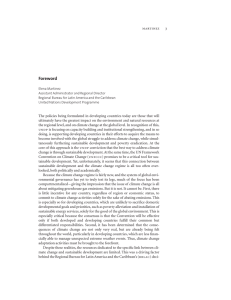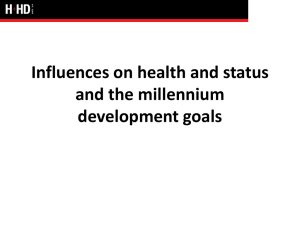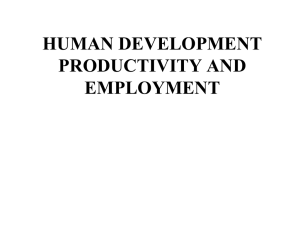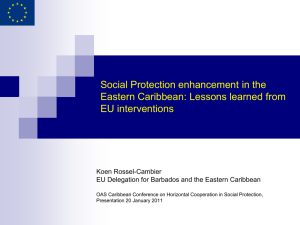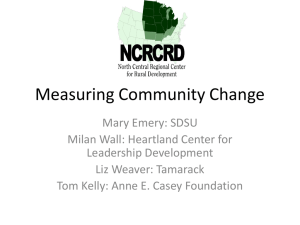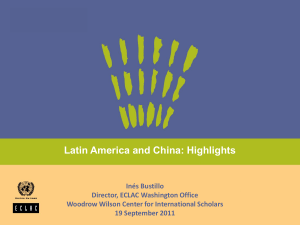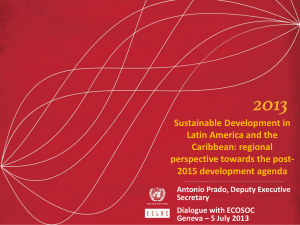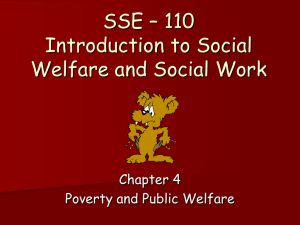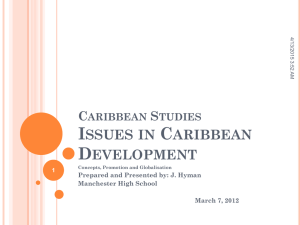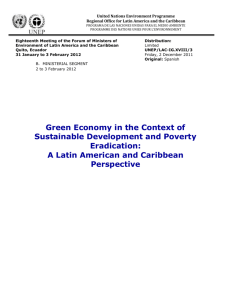Presentation - Achieving Impact 2014
advertisement
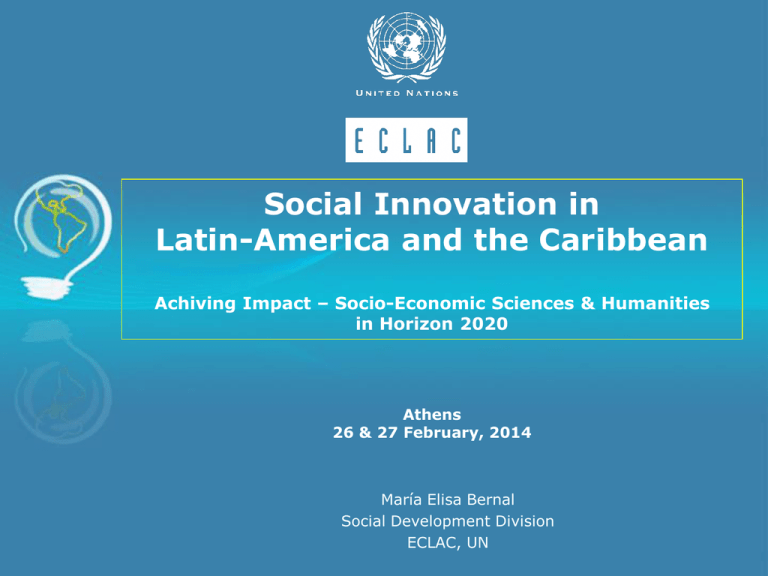
Social Innovation in Latin-America and the Caribbean Achiving Impact – Socio-Economic Sciences & Humanities in Horizon 2020 Athens 26 & 27 February, 2014 María Elisa Bernal Social Development Division ECLAC, UN The presentation is based on the Project “Experiences in social innovation in LatinAmerica and the Caribbean” (ECLAC- Kellogg Foundation) Clear conclusions: Latin America and the Caribbean is a “boom" of social innovations. At least in part, because we never have had a true Welfare State such as the Europeans Even though ..... Social expenditure: Countercyclical Social programs such as conditional cash transfer. Issues: Quality or coverage of education or health, income generation, youth programs, with enormous gaps and where the population faces serious problems. Rural areas in general and in even more remote places have lower access to social services and higher levels of poverty Overview of LAC: Progress in reducing poverty and extreme poverty and reached almost all MDGs Evolution of poverty and extreme poverty These are averages: Haiti (80%), Honduras (70), Uruguay (10%) There are still very difficult "pockets" to attend, and there are some goals that the region might not be able to achieve ( Ex Maternal Mortality). The region is the most unequal of the Word 80 70 60 50 40 30 20 Mean 10 Max 0 Min Share of total income (In percentages) 60 50 40 30 Uruguay Venezuela El Salvador Bolivia Ecuador Argentina Perú Nicaragua México Chile Paraguay Honduras Guatemala 0 Panamá Q5 Costa Rica 10 Colombia Q1 República… 20 Brasil Inequality (Gini%) Poverty is not only income. HDI= Income + life expectancy at birth + education Latin America has an average HDI which puts us not far from Europe and Central Asia Human Development Index 2012 Again, these are averages…. There are huge differences. Chile is the highest (Rank 40, 0.81), the lowest Haiti (Rank 161, 0.45, 62.4, 4.7), followed by Guatemala (Rank 131, 0.58, 71.4, 4.1) How will they get out of poverty in these countries where schooling is less than 5 years? Not even finishing primary. These differences between countries are replicated within them. For example, in Brazil, life expectancy at birth is 14 years higher for the highest quintal than the lowest. In education, in Sao Paulo 100% of children aged 5 and 6 years attend school but in Melgaco in the State of Para, only 59% attend school. There is no doubt that under these conditions society must be creative to find new solutions to traditional problems. Our definition of Social Innovation New ways of doing tasks, new tasks, new ways of execution or management And it has to be: •Cost – efficiency relation better than the one in traditional models, •Has the potential to be replicated in the country originated as well as in other countries of the region, •Has proved its financial and political sustainability •Has the possibility of becoming public policy, •Has impacts on the poverty determinants, •Has the potential to reduce discrimination and exclusion, and •Very important to ECLAC, promoting and strengthening the participation of the community, as a contribution to the citizenship and therefore the strengthening of democracy. Characteristics of social innovation in Latin America and the Caribbean Social innovations have primarily arisen from the civil society, the communities or a virtuous combination of these two, but always with a major participation of the people. The community has the capacity to identify the most pressing problems and with the support of the external agents, analyze the feasibility of alternative solutions. Social innovation generally arises as a response to a crisis or extreme poverty in any of its determinants. Developing and facilitating synergies between technical and modern knowledge with traditional and sometimes ancestral knowledge. In the productive projects in all cases, developing associative models. Promoting partnerships with government at different levels, with civil society, unions and even with the private sector. More characteristics ….. The innovative projects generally received external financial support; key for the developing of the innovation if the financing agent understood the cycle that requires for the development of innovation and do not expect results in a very short time. Despite the huge number of innovations generated in the region, the scale-up of the innovative model and therefore its ability to affect large proportions of the population is very low. The scale-up could only be achieved when this new model becomes public policy, from the local to the national level. Unfortunately, very few governments, at any level, do that. Characteristics of social innovation in income generation Emerged at a time when some adverse conditions have worsened. For example, the Argentina crisis in the earlier 2000, the security situation in the Peruvian highlands, or the forced eradication of illicit crops in Colombia. The idea of seeking new alternatives arises from the members of the community on an individual or collective leadership, and always starts with associative models. The output is related to both new products and the improvement in the conditions of production in particular levels of quality, productivity and competitiveness what they accomplish with associability. In most cases the key is the support of an external agent, in a joint effort based on the synergy between modern scientific and technical knowledge with the local, even in some cases ancient knowledge. A vertical integration process is part of the success of these models. The presence of government is generally very low, the maximum participation is to request documents. (It’s not good) Results and example They have been able to increase their income Example: Let Agogo, Haiti From extreme poverty their income is now equal to the average of the country. Characteristics of social innovation in education Work to reduce school dropout rates; increase accessibility, especially in rural areas and increase the quality of education especially in the context of intercultural education. There is always a strong presence of an external agent (NGO) that mobilized the educational community around the idea that the situation could be changed and improved. With the community, the external agent carries on the diagnosis that allows the design of alternatives to be discussed with this community. In all cases the active participation of the educational community, in the entire process including implementation, is crucial for the success of innovation. The external agent works to build and strengthen local leadership that will be able to continue the process once the agent retires. The local government allows testing the "idea" and when the model has been proved and validated, actively participates and even finances some components or the all activities, with the public budget, allowing the model to grow. In countries where participatory budgeting is used the community, committed to the model, support it’s financing with the local budget and make it possible to remain independent of management changes. Results and example They have been able to reduce dropouts but the quality of education has been a more complex achievement because while it is true that the quality of education has been improved, reaching the levels of urban schools for the upper class has been impossible. For example, improvement in reading comprehension and then improving the learning process, but of course their teachers continue to have lower levels. Example: Family Housing for Students , Bolivia Characteristics of social innovation in Health Work in reducing infant and maternal mortality, attention to dispersed and difficult to access population, improvement in the quality and relevance of care. It is the sector where government presence is higher. It is the concern of the local health authorities against certain indexes that move the search for new solutions. Also the success of innovation and one of the innovative features is the active participation of community members in the diagnostic process and searches for alternative solutions. This way of working, where health comes from the uniqueness of the medical world, has identified socioeconomic factors underlying health problems. It is not as obvious to identify, for example that poverty affects health by drinking no-potable water. Structural factors have been addressed and resolved, positively affecting health indicators. Non-governmental organizations are taking great challenges especially with regard dispersed populated and difficult to access population. Gradually they design and test models, cost efficient, but at the same time, able to ensure the access to the right of health. Usually, at the beginning, the project is financed with external resources and when they could prove that it works, the government, first the local and then the intermediate, support the model even funding partially actions to finally make it public program in which development NGOs becomes the coordinator of the activities. Results and example They have been able to: Reduce infant and maternal mortality as well as other health indicators Increase the accessibility to health services “Four-Leaf Clover” Strategy to Reduce Maternal and Infant Mortality, Brazil Community Health Actions in the Tapajós National Forest, Brazil Summary Latin America and the Caribbean is extremely creative but more active action is required by government authorities to achieve significant increase in the scale of work. Universities and research centers such as those gathered here can play a central role in several areas: In the development of social innovations, acting as an external agent that supports and accompanies the communities in diagnosing the problems and find the alternative solutions. In the evaluation of the social innovations and, in the promotion of government programs and policies using those innovative models. Latin America has a lot of social innovation experiences that could share with Europe, specially to work with the migrants. Thank you !!! The information of the social innovative experiences in Latin America and the Caribbean could be find in: www.cepal.org/dds/innovacionsocial
